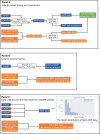AI4AMP: an Antimicrobial Peptide Predictor Using Physicochemical Property-Based Encoding Method and Deep Learning
- PMID: 34783578
- PMCID: PMC8594441
- DOI: 10.1128/mSystems.00299-21
AI4AMP: an Antimicrobial Peptide Predictor Using Physicochemical Property-Based Encoding Method and Deep Learning
Abstract
Antimicrobial peptides (AMPs) are innate immune components that have recently stimulated considerable interest among drug developers due to their potential as antibiotic substitutes. AMPs are notable for their fundamental properties of microbial membrane structural interference and the biomedical applications of killing or suppressing microbes. New AMP candidates must be developed to oppose antibiotic resistance. However, the discovery of novel AMPs through wet-lab screening approaches is inefficient and expensive. The prediction model investigated in this study may help accelerate this process. We collected both the up-to-date AMP data set and unbiased negatives based on which the protein-encoding methods and deep learning model for AMPs were investigated. The external testing results indicated that our trained model achieved 90% precision, outperforming current methods. We implemented our model on a user-friendly web server, AI4AMP, to accurately predict the antimicrobial potential of a given protein sequence and perform proteome screening. IMPORTANCE Antimicrobial peptides (AMPs) are innate immune components that have aroused a great deal of interest among drug developers recently, as they may become a substitute for antibiotics. New candidates need to fight antibiotic resistance, while discovering novel AMPs through wet-lab screening approaches is inefficient and expensive. To accelerate the discovery of new AMPs, we both collected the up-to-date antimicrobial peptide data set and integrated the protein-encoding methods with a deep learning model. The trained model outperforms the current methods and is implemented into a user-friendly web server, AI4AMP, to accurately predict the antimicrobial properties of a given protein sequence and perform proteome screening. Author Video: An author video summary of this article is available.
Keywords: antimicrobial peptide; deep learning; protein-encoding method; real-world data; web service.
Figures






Similar articles
-
dbAMP: an integrated resource for exploring antimicrobial peptides with functional activities and physicochemical properties on transcriptome and proteome data.Nucleic Acids Res. 2019 Jan 8;47(D1):D285-D297. doi: 10.1093/nar/gky1030. Nucleic Acids Res. 2019. PMID: 30380085 Free PMC article.
-
Deep Learning Accelerates the Development of Antimicrobial Peptides Comprising 15 Amino Acids.Assay Drug Dev Technol. 2025 Mar 27. doi: 10.1089/adt.2025.011. Online ahead of print. Assay Drug Dev Technol. 2025. PMID: 40139786
-
CalcAMP: A New Machine Learning Model for the Accurate Prediction of Antimicrobial Activity of Peptides.Antibiotics (Basel). 2023 Apr 7;12(4):725. doi: 10.3390/antibiotics12040725. Antibiotics (Basel). 2023. PMID: 37107088 Free PMC article.
-
Recent Progress in the Discovery and Design of Antimicrobial Peptides Using Traditional Machine Learning and Deep Learning.Antibiotics (Basel). 2022 Oct 21;11(10):1451. doi: 10.3390/antibiotics11101451. Antibiotics (Basel). 2022. PMID: 36290108 Free PMC article. Review.
-
Antimicrobial Peptides and Their Biomedical Applications: A Review.Antibiotics (Basel). 2024 Aug 23;13(9):794. doi: 10.3390/antibiotics13090794. Antibiotics (Basel). 2024. PMID: 39334969 Free PMC article. Review.
Cited by
-
The limits of prediction: Why intrinsically disordered regions challenge our understanding of antimicrobial peptides.Comput Struct Biotechnol J. 2024 Feb 12;23:972-981. doi: 10.1016/j.csbj.2024.02.008. eCollection 2024 Dec. Comput Struct Biotechnol J. 2024. PMID: 38404711 Free PMC article.
-
AmpHGT: expanding prediction of antimicrobial activity in peptides containing non-canonical amino acids using multi-view constrained heterogeneous graph transformer.BMC Biol. 2025 Jul 1;23(1):184. doi: 10.1186/s12915-025-02253-4. BMC Biol. 2025. PMID: 40598389 Free PMC article.
-
Peptide-Based Drug Predictions for Cancer Therapy Using Deep Learning.Pharmaceuticals (Basel). 2022 Mar 30;15(4):422. doi: 10.3390/ph15040422. Pharmaceuticals (Basel). 2022. PMID: 35455418 Free PMC article.
-
DeepAFP: An effective computational framework for identifying antifungal peptides based on deep learning.Protein Sci. 2023 Oct;32(10):e4758. doi: 10.1002/pro.4758. Protein Sci. 2023. PMID: 37595093 Free PMC article.
-
Examining the functional space of gut microbiome-derived peptides.Microbiologyopen. 2023 Dec;12(6):e1393. doi: 10.1002/mbo3.1393. Microbiologyopen. 2023. PMID: 38129980 Free PMC article.
References
-
- Magana M, Pushpanathan M, Santos AL, Leanse L, Fernandez M, Ioannidis A, Giulianotti MA, Apidianakis Y, Bradfute S, Ferguson AL, Cherkasov A, Seleem MN, Pinilla C, de la Fuente-Nunez C, Lazaridis T, Dai T, Houghten RA, Hancock REW, Tegos GP. 2020. The value of antimicrobial peptides in the age of resistance. Lancet Infect Dis 20:e216–e230. doi:10.1016/S1473-3099(20)30327-3. - DOI - PubMed
-
- Spohn R, Daruka L, Lázár V, Martins A, Vidovics F, Grézal G, Méhi O, Kintses B, Számel M, Jangir PK, Csörgő B, Györkei Á, Bódi Z, Faragó A, Bodai L, Földesi I, Kata D, Maróti G, Pap B, Wirth R, Papp B, Pál C. 2019. Integrated evolutionary analysis reveals antimicrobial peptides with limited resistance. Nat Commun 10:4538. doi:10.1038/s41467-019-12364-6. - DOI - PMC - PubMed
Grants and funding
LinkOut - more resources
Full Text Sources
Miscellaneous

